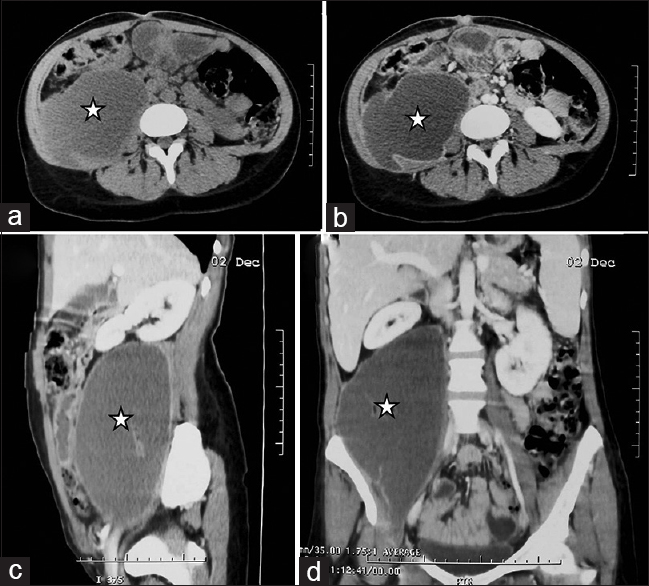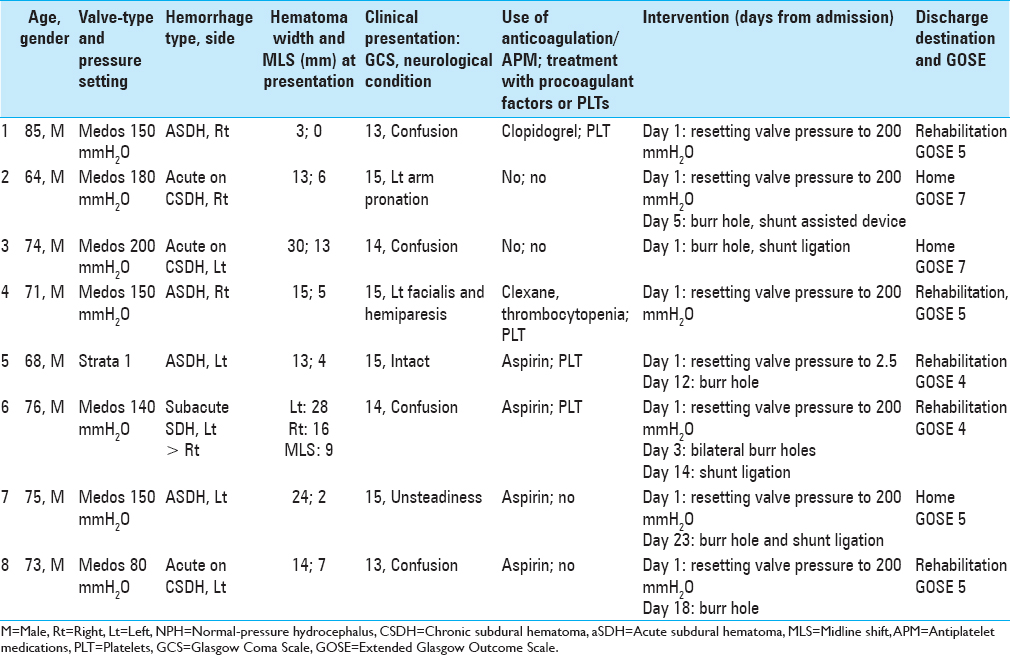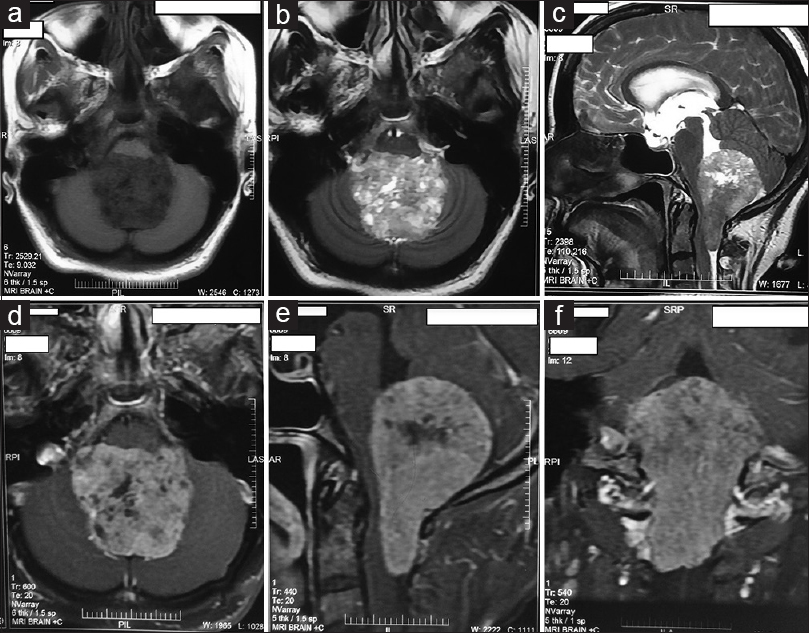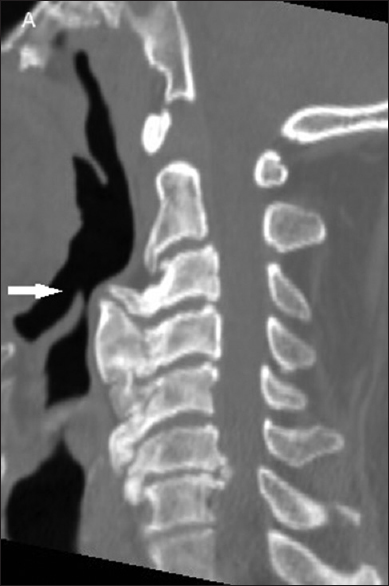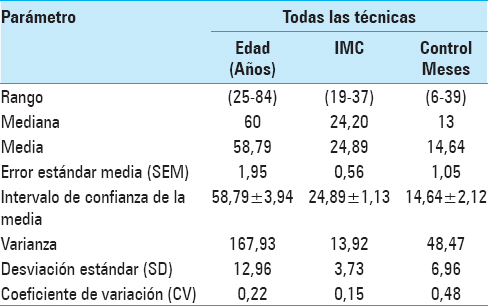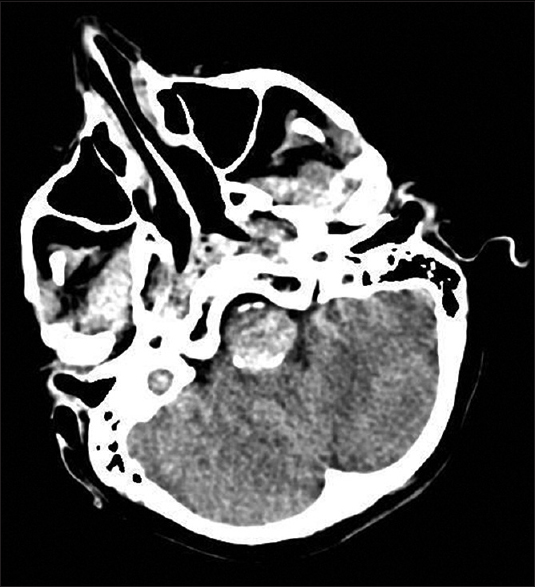Primary tuberculous psoas abscess as a postpartum complication: Case report and literature review
Date of publication: 28-Nov-2018
Background:Primary psoas abscess is an unusual clinical entity rarely encountered in the postpartum period. Only seven cases have been reported to date. Here, we present a woman with a primary psoas abscess caused by Mycobacterium tuberculosis and occurred 2 months following a normal vaginal birth. We highlight the difficulties in the management of this uncommon condition in light of the relevant literature.
Acute subdural hematomas in shunted normal-pressure hydrocephalus patients – Management options and literature review: A case-based series
Date of publication: 28-Nov-2018
Background:Ventriculoperitoneal shunting (VPS) is considered a risk factor for developing subdural hematomas (SDH). Treating cases of acute SDH (aSDH) in shunted normal-pressure hydrocephalus (NPH) patients can be challenging, and data in this field are scarce. We report our experience treating shunted NPH patients presenting with aSDH.
Fourth ventricle meningioma with cervical extension: An unusual entity
Date of publication: 28-Nov-2018
Clinical and radiological features of Forestier's disease presenting with dysphagia
Date of publication: 28-Nov-2018
Background:Diffuse idiopathic skeletal hyperostosis (DISH), also known as Forestier's disease, is a rheumatologic condition characterized by ossification of the spinal ligaments and tendons. Large anterior osteophytes are typically present in the lower cervical levels, while upper cervical ossification resulting in dysphagia is very rare.
Unedited microneurosurgery of a posterior fossa pilocytic astrocytoma
Date of publication: 28-Nov-2018
Background:Pilocytic astrocytoma (PA) is a WHO grade I glioma and the most common pediatric brain tumor. PA is most commonly localized in the cerebellum with extremely rare disemination and progression to higher grade astrocytomas. Thus, overall survival rates are excellent after gross total resection. Herein, we present an unedited microneurosurgery of a histologically confirmed cerebellar PA. Our aim is to demonstrate the efficiency and safety of our microsurgical technique into deep brain territories. For this, a paramedian supracerebellar infratentorial approach and a proper praying sitting position are essential.
Unedited microneurosurgery of a large recurrent papillary tumor of the pineal region
Date of publication: 28-Nov-2018
Background:Papillary tumor of the pineal region (PTPR) is a new entity introduced in the 2007 World Health Organization (WHO) nomenclature to describe a rare grade II–III pineal lesion with epithelial-like papillary architecture and particular immunohistochemical features. PTPR is extremely rare in children. Herein, we present an unedited gross total microsurgical resection of a histologically confirmed WHO grade III PTPR. Our aim is to demonstrate the efficiency and safety of our microsurgical technique into deep brain territories under the principle “simple, clean, and preserving the normal anatomy.” For this, a posterior occipital interhemispheric approach and a proper praying sitting position were essential.
Microsurgical clipping of a large ruptured anterior communicating artery aneurysm
Date of publication: 28-Nov-2018
Background:Anterior communicating artery (AComA) aneurysms are the most complex aneurysms of the anterior cerebral circulation. They mostly arise between the dominant A1 and the AComA, and are associated with intraventricular hemorrhage or other aneurysms in around 20%–30% of the cases. Giant and fusiform aneurysms are rare in this location in contrast to the common small ruptured aneurysms. Throughout the treatment, branches of A1–A2 complex such as the orbitofrontal artery, the frontopolar artery, the recurrent artery of Heubner, medial lenticulostriate arteries, and small perforators from the A1–A2 junction should be preserved. The orientation of the aneurysm, undefined in case of tortuous A1, but usually to the contralateral side of the dominant A1, might be downward, forward, upward, backward, or even of a complex morphology. Moreover, the evaluation of the chiasm and skull base, the site of possible rupture, the presence of intraluminal thrombosis, vascular calcifications, or anatomic variations of A1 and A2 segments is required. Since the angle between the AComA perforators and the A2s varies between 30° and 180°, parallel application of the clip along the AComA is unrecommended.
Unedited microneurosurgery of a solitary fibrous tumor of the pineal region
Date of publication: 28-Nov-2018
Background:Solitary fibrous tumor/hemangiopericytoma is a new combined entity introduced in the 2016 World Health Organization classification of tumors of the central nervous system for grade I–III soft-tissue tumors. While grades II and III present more aggressive course and might require adjuvant radiochemotherapy, grade I tumors have a good outcome after gross total resection. In this video-abstract, we present an unedited microneurosurgery of a histologically confirmed benign solitary fibrous tumor of the pineal region performed by a senior author (JH). Our aim is to demonstrate the efficiency and safety of our microsurgical technique into deep brain territories under the principle “simple, clean, and preserving the normal anatomy.” For this, a paramedian supracerebellar infratentorial approach and a proper praying sitting position are essential.
Atrofia paraespinal postoperatoria. ¿El abordaje importa?
Date of publication: 26-Nov-2018
Objetivo:comparar la magnitud de la atrofia muscular postoperatoria que producen tres abordajes en fusiones lumbares segmentarias para patología degenerativa. (línea media vs Wiltse vs MIS TLIF).
Aneurisma gigante de arteria vertebral en paciente de edad pediátrica
Date of publication: 26-Nov-2018
Objetivo:Describir el caso de un paciente pediátrico portador de un aneurisma gigante de arteria vertebral tratado mediante clipado microquirúrgico.


